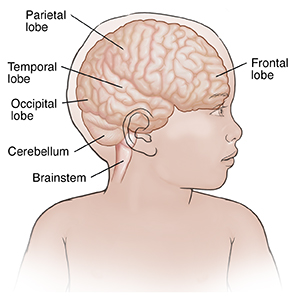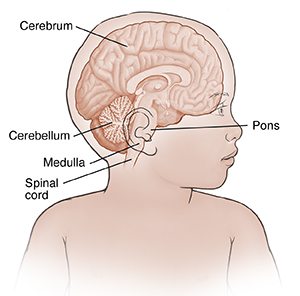Anatomy of a Child's Brain
What is the central nervous system (CNS)?
The central nervous system (CNS) is the brain and spinal cord. The brain is an important organ. It controls thought, memory, emotion, touch, motor skills, vision, breathing, temperature, hunger, and every process that regulates our body. The brain is responsible for how your child interacts with others. It defines their personality.
What are the different parts of the brain?


The brain can be divided into 3 main parts:
-
Cerebrum. The cerebrum is the front part of the brain. It has a right and left hemisphere. Functions of the cerebrum include initiation of movement, coordination of movement, temperature, touch, vision, hearing, speech and language, judgment, reasoning, problem solving, emotions, and learning. Memory, appreciation for art and music, abstract thought, and humor are all controlled by the cerebrum.
-
Brainstem. The brainstem is the middle of the brain. It includes the midbrain, the pons, and the medulla. Functions of this part include movement of the eyes and mouth, relaying sensory messages (such as, hot, pain, or loud), hunger, respirations, consciousness, cardiac function, body temperature, involuntary muscle movements, sneezing, coughing, vomiting, and swallowing.
-
Cerebellum. The cerebellum is the back of the brain. It is located at the back of the head. Its function is to coordinate voluntary muscle movements. It also maintains posture, balance, and equilibrium.
Within these 3 main parts, there are these other parts of the brain:
-
Pons. This is a deep part of the brain located in the brainstem. It contains many of the control areas for eye and face movements and sensation.
-
Medulla. This is the lowest part of the brainstem. It is the most vital part of the entire brain. It contains important control centers for swallowing, breathing, and the heart and lungs. It also controls wakefulness.
-
Spinal cord. This is a large bundle of nerve fibers in the back that extends from the base of the brain to the lower back. It carries messages to and from the brain and the rest of the body.
-
Frontal lobe. This is the largest section of the brain. It is located in the front of the head. The frontal lobe is involved in judgment, decision-making, some language functions, personality characteristics, and movement.
-
Parietal lobe. This is the middle part of the brain. It helps a person to identify objects and understand spatial relationships (where one's body is compared to objects around the person). It also helps with vision, hearing, and memory. And it is involved in interpreting pain and touch in the body.
-
Occipital lobe. This is the back part of the brain. It is involved with vision.
-
Temporal lobes. These are the sides of the brain. They are involved in memory, speech, language processing, and sense of smell.
Online Medical Reviewer:
Anne Fetterman RN BSN
Online Medical Reviewer:
Joseph Campellone MD
Online Medical Reviewer:
Raymond Kent Turley BSN MSN RN
Date Last Reviewed:
2/1/2023
© 2000-2025 The StayWell Company, LLC. All rights reserved. This information is not intended as a substitute for professional medical care. Always follow your healthcare professional's instructions.